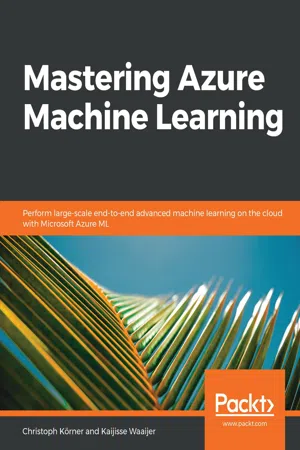
Mastering Azure Machine Learning
Perform large-scale end-to-end advanced machine learning on the cloud with Microsoft Azure ML
- 394 pages
- English
- ePUB (mobile friendly)
- Available on iOS & Android
Mastering Azure Machine Learning
Perform large-scale end-to-end advanced machine learning on the cloud with Microsoft Azure ML
About This Book
Master expert techniques for building automated and highly scalable end-to-end machine learning models and pipelines in Azure using TensorFlow, Spark, and Kubernetes
Key Features
- Make sense of data on the cloud by implementing advanced analytics
- Train and optimize advanced deep learning models efficiently on Spark using Azure Databricks
- Deploy machine learning models for batch and real-time scoring with Azure Kubernetes Service (AKS)
Book Description
The increase being seen in data volume today requires distributed systems, powerful algorithms, and scalable cloud infrastructure to compute insights and train and deploy machine learning (ML) models. This book will help you improve your knowledge of building ML models using Azure and end-to-end ML pipelines on the cloud.
The book starts with an overview of an end-to-end ML project and a guide on how to choose the right Azure service for different ML tasks. It then focuses on Azure Machine Learning and takes you through the process of data experimentation, data preparation, and feature engineering using Azure Machine Learning and Python. You'll learn advanced feature extraction techniques using natural language processing (NLP), classical ML techniques, and the secrets of both a great recommendation engine and a performant computer vision model using deep learning methods. You'll also explore how to train, optimize, and tune models using Azure Automated Machine Learning and HyperDrive, and perform distributed training on Azure. Then, you'll learn different deployment and monitoring techniques using Azure Kubernetes Services with Azure Machine Learning, along with the basics of MLOps—DevOps for ML to automate your ML process as CI/CD pipeline.
By the end of this book, you'll have mastered Azure Machine Learning and be able to confidently design, build and operate scalable ML pipelines in Azure.
What you will learn
- Setup your Azure Machine Learning workspace for data experimentation and visualization
- Perform ETL, data preparation, and feature extraction using Azure best practices
- Implement advanced feature extraction using NLP and word embeddings
- Train gradient boosted tree-ensembles, recommendation engines and deep neural networks on Azure Machine Learning
- Use hyperparameter tuning and Azure Automated Machine Learning to optimize your ML models
- Employ distributed ML on GPU clusters using Horovod in Azure Machine Learning
- Deploy, operate and manage your ML models at scale
- Automated your end-to-end ML process as CI/CD pipelines for MLOps
Who this book is for
This machine learning book is for data professionals, data analysts, data engineers, data scientists, or machine learning developers who want to master scalable cloud-based machine learning architectures in Azure. This book will help you use advanced Azure services to build intelligent machine learning applications. A basic understanding of Python and working knowledge of machine learning are mandatory.
Frequently asked questions
Information
Section 1: Azure Machine Learning
- Chapter 1, Building an end-to-end machine learning pipeline in Azure
- Chapter 2, Choosing a machine learning service in Azure
1. Building an end-to-end machine learning pipeline in Azure
- Performing descriptive data exploration
- Common techniques for data preparation
- Choosing the right ML model to train data
- Optimization techniques
- Deploying and operating models
Performing descriptive data exploration
- Analyze the data distribution and check for the following:
- Data types (continuous, ordinal, nominal, or text)
- Mean, median, and percentiles
- Data skew
- Outliers and minimum and maximum values
- Null and missing values
- Most common values
- The number of unique values (in categorical features)
- Correlations (in continuous features)
- Analyze how the target variable is influenced by the features and check for the following:
- The regression coefficient (in regression)
- Feature importance (in classification)
- Categorical values with high error rates (in binary classification)
- Analyze the difficulty of your prediction task.
Note
Moving data to the cloud
Understanding missing values
Note
Note
- The absolute number (or percentage) of the null values (look for Null, "Null", "", NaN, and so on)
- The absolute number (or percentage) of minimum and maximum values The absolute number (or percentage) of the most common value (MODE) The absolute number (or percentage) of value 0
- The absolute number (or percentage) of unique values
Table of contents
- Preface
- Section 1: Azure Machine Learning
- 1. Building an end-to-end machine learning pipeline in Azure
- 2. Choosing a machine learning service in Azure
- Section 2: Experimentation and Data Preparation
- 3. Data experimentation and visualization using Azure
- 4. ETL, data preparation, and feature extraction
- 5. Azure Machine Learning pipelines
- 6. Advanced feature extraction with NLP
- Section 3: Training Machine Learning Models
- 7. Building ML models using Azure Machine Learning
- 8. Training deep neural networks on Azure
- 9. Hyperparameter tuning and Automated Machine Learning
- 10. Distributed machine learning on Azure
- 11. Building a recommendation engine in Azure
- Section 4: Optimization and Deployment of Machine Learning Models
- 12. Deploying and operating machine learning models
- 13. MLOps—DevOps for machine learning
- 14. What's next?
- Index